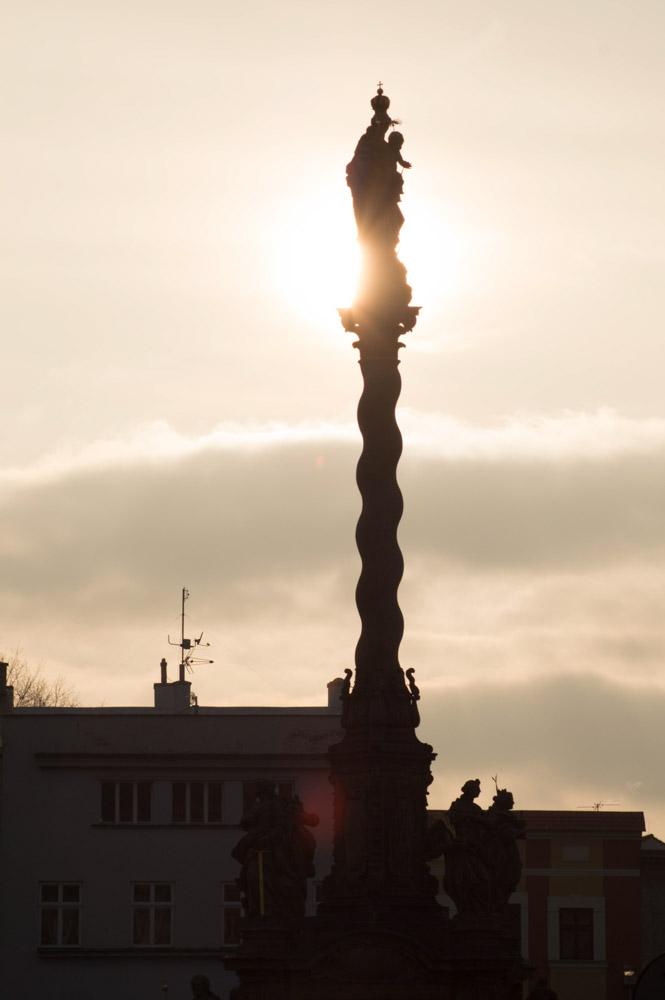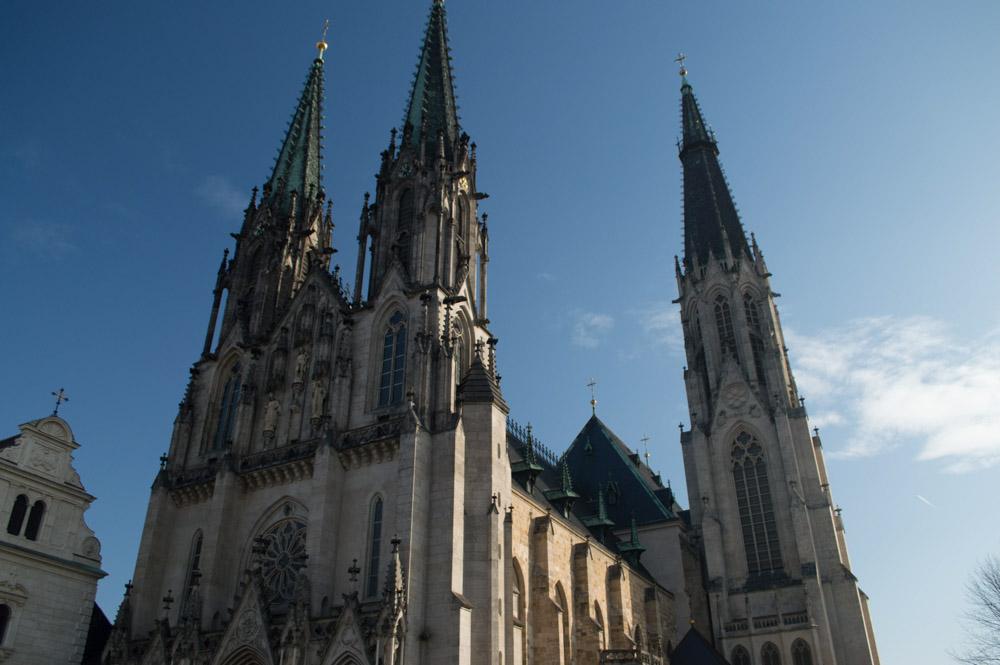After quite a busy while elsewhere, my thoughts have once again returned to the historic Moravian capital of Olomouc and I wish to share the rest of the knowledge I gained of this beautiful city. Amid the dreary February weather that smothers Poprad and the Tatras, I am grateful for the beautiful (if chilly) days in which I was able to explore and photograph Olomouc’s labyrinthine streets.
Astronomical Clock

Horní náměstí (The Upper Square) is one of the city’s most decorated spaces. Like many old European cities, it is adorned with intricate facades and classical statues, like the ones described in my previous post on Olomouc. The City Hall, with its splendid clock-tower, dominates the skyline with uniquely Baroque elegance. Yet, something is out of place amid all these antiquated features.
Into the face of that tower is built an astronomical clock, one of only two in the Czech Republic. After a great deal of damage during WWII, the original 15th century construction was ordered to be rebuilt in the 50s by the communist government of Czechoslovakia. The style and motifs portrayed belong to that of the now uncommon Socialist Realist style. Instead of portraying saints and religious imagery–as its predecessor had–the restored astronomical clock depicted the working classes. At the top, a procession of people in folk costume celebrate, while below a carousel of various laborers, shoppers, and athletes go about their daily lives every half hour. The largest figures featured in the mosaic are that of a worker in a blue jumper and a chemist opposite him.
The oddity of this site is striking. To reach it from any direction you must walk past at least two or three statues of mythological figures, each idyllically draped in cloth and striking a legendary pose. Then, where you can’t help but expect the same, is a man holding a beaker, appearing like a stereotypical scientist who stepped from some cartoon. Nevertheless, on a whole the monument truly harmonizes with its surroundings. Unlike most soviet-era eyesores, effort was spent to respect the history and ascetic of the square and I can’t help but believe that the communist artists… may, to some eyes, have actually improved Horní náměstí.
On my second visit to Olomouc, I caught the clock’s noon display! Running late, I sped towards the square to catch a spectacle I thought I may not get to witness again. I have no idea what I expected, but it suffices to say I was humorously underwhelmed. A couple ditties chimed while the proletarians spun away on their carousal and a rooster noisly thrust back and forth from his perch. I found myself chuckling at the near 10 minute length of this mediocrity, feeling obliged to stay throughout it all, just in case something exceptional happened.
That something never came, however, and I wasn’t that disappointed either. The truly exceptional thing about an astronomic clock occurs over days, months and years, not in a few minutes alone. These constructions, which number very few nowadays, display the day of the week, month, year, season, phase of the moon, zodiac houses, and a map of currently visible stars. They are amazing contraptions and the fact that people as early as the 15th century could devise such an accurate instrument astounds me.
Czechs and Slovaks maintain the tradition of celebrating the day of the saint for which they are named. It is like a milder version of their birthday, with small gifts and candy being given. The Olomouc astronomical clock displays the Czech names for all 365 days of the calendar, as well as holidays, including communist era ones such as the International day of the Worker and the birthdays of Lenin and Stalin.
The Holy Trinity Column

Not far from the secular, Soviet clock, a gargantuan spire rises above the entire square. The Holy Trinity Column, contrastingly, was erected (partially) out of gratitude to God for sparing the city of Olomouc from destruction by a plague that swept the area between 1713 and 1715. Mostly, it is a representation of the affluence of 18th century Olomouc and its devotion to and desire to glorify God. Construction began at the end of that particular plague and lasted nearly 40 years! In that time, six of the seven head craftsmen that labored on the column passed away and only the master goldsmith, Simon Forstner, who gilded parts of the monument survived to see it completed in its entirety.
The Holy Trinity Column became a symbol of pride for the people of Olomouc. It was a true product of their city alone. All who worked on the column were natives, unlike the Italians and Germans which had predominantly designed the city’s iconic fountains.
Because of this devotion to their new landmark, Olomouc was understandably mortified when the Prussians besieged the city only a few years later and hit the column with several cannon balls. A procession of citizens confronted the Prussian forces and asked that they cease firing at the monument. In a surprising and sympathetic turn, their enemies complied and spared it further damage. After the conflict, the craters left by the Prussian artillery were filled, but one, sole gilded ball left in the spot where one of the cannon balls had stuck to memorialize the event. You can see it just above the head of the central figure on the second tier down in the above shot.
This column is not the only one in Olomouc. In the lower square a similar, though more modest, monument stands. It is referred to specifically as a Marian Column, one featuring the Virgin Mary and inspired by the gratitude surrounding the end of a plague. This is in fact the true plague monument in Olomouc, its glory stolen by the larger neighbor.
As before, here are a few more random photos from across the city, including shots of the Saint Wenceslas Cathedral. Its spires are the second highest in the Czech Republic and the whole structure is deserving of its own post, though I believe that must wait for another visit to this fine city.
Signed,
Andrew
Sources-
http://www.outsideprague.com/olomouc/astronomical_clock.html





